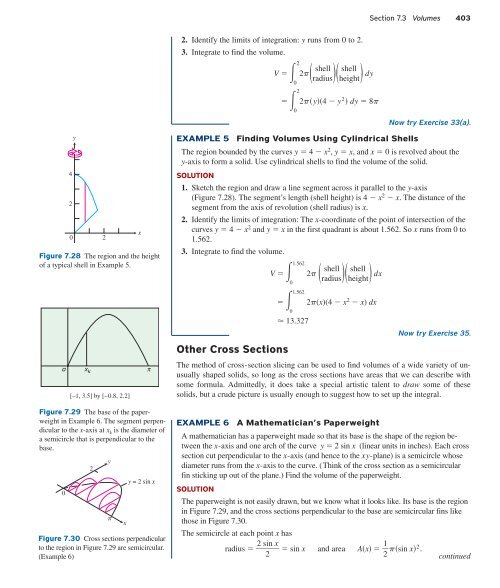Create successful ePaper yourself
Turn your PDF publications into a flip-book with our unique Google optimized e-Paper software.
Section 7.3 Volumes 403<br />
2. Identify the limits of integration: y runs from 0 to 2.<br />
3. Integrate to find the volume.<br />
V 2<br />
0<br />
2<br />
0<br />
2p( radius)( shell<br />
height) shell dy<br />
2py4 y 2 dy 8p<br />
Now try Exercise 33(a).<br />
4<br />
2<br />
y<br />
0 2<br />
Figure 7.28 The region and the height<br />
of a typical shell in Example 5.<br />
o<br />
x k<br />
[–1, 3.5] by [–0.8, 2.2]<br />
Figure 7.29 The base of the paperweight<br />
in Example 6. The segment perpendicular<br />
to the x-axis at x k is the diameter of<br />
a semicircle that is perpendicular to the<br />
base.<br />
0<br />
2<br />
y<br />
x<br />
x<br />
π<br />
y = 2 sin x<br />
Figure 7.30 Cross sections perpendicular<br />
to the region in Figure 7.29 are semicircular.<br />
(Example 6)<br />
<br />
EXAMPLE 5<br />
Finding Volumes Using Cylindrical Shells<br />
The region bounded by the curves y 4 x 2 , y x, and x 0 is revolved about the<br />
y-axis to form a solid. Use cylindrical shells to find the volume of the solid.<br />
SOLUTION<br />
1. Sketch the region and draw a line segment across it parallel to the y-axis<br />
(Figure 7.28). The segment’s length (shell height) is 4 x 2 x. The distance of the<br />
segment from the axis of revolution (shell radius) is x.<br />
2. Identify the limits of integration: The x-coordinate of the point of intersection of the<br />
curves y 4 x 2 and y x in the first quadrant is about 1.562. So x runs from 0 to<br />
1.562.<br />
3. Integrate to find the volume.<br />
Other Cross Sections<br />
radius)( height) shell dx<br />
1.562<br />
2p(x)(4 x 2 x) dx<br />
0<br />
13.327<br />
1.562<br />
V 2p ( shell<br />
0<br />
Now try Exercise 35.<br />
The method of cross-section slicing can be used to find volumes of a wide variety of unusually<br />
shaped solids, so long as the cross sections have areas that we can describe with<br />
some formula. Admittedly, it does take a special artistic talent to draw some of these<br />
solids, but a crude picture is usually enough to suggest how to set up the integral.<br />
EXAMPLE 6<br />
A Mathematician’s Paperweight<br />
A mathematician has a paperweight made so that its base is the shape of the region between<br />
the x-axis and one arch of the curve y 2 sin x (linear units in inches). Each cross<br />
section cut perpendicular to the x-axis (and hence to the xy-plane) is a semicircle whose<br />
diameter runs from the x-axis to the curve. (Think of the cross section as a semicircular<br />
fin sticking up out of the plane.) Find the volume of the paperweight.<br />
SOLUTION<br />
The paperweight is not easily drawn, but we know what it looks like. Its base is the region<br />
in Figure 7.29, and the cross sections perpendicular to the base are semicircular fins like<br />
those in Figure 7.30.<br />
The semicircle at each point x has<br />
radius 2s in x<br />
sin x and area Ax 1 2<br />
2 psin x2 .<br />
continued












